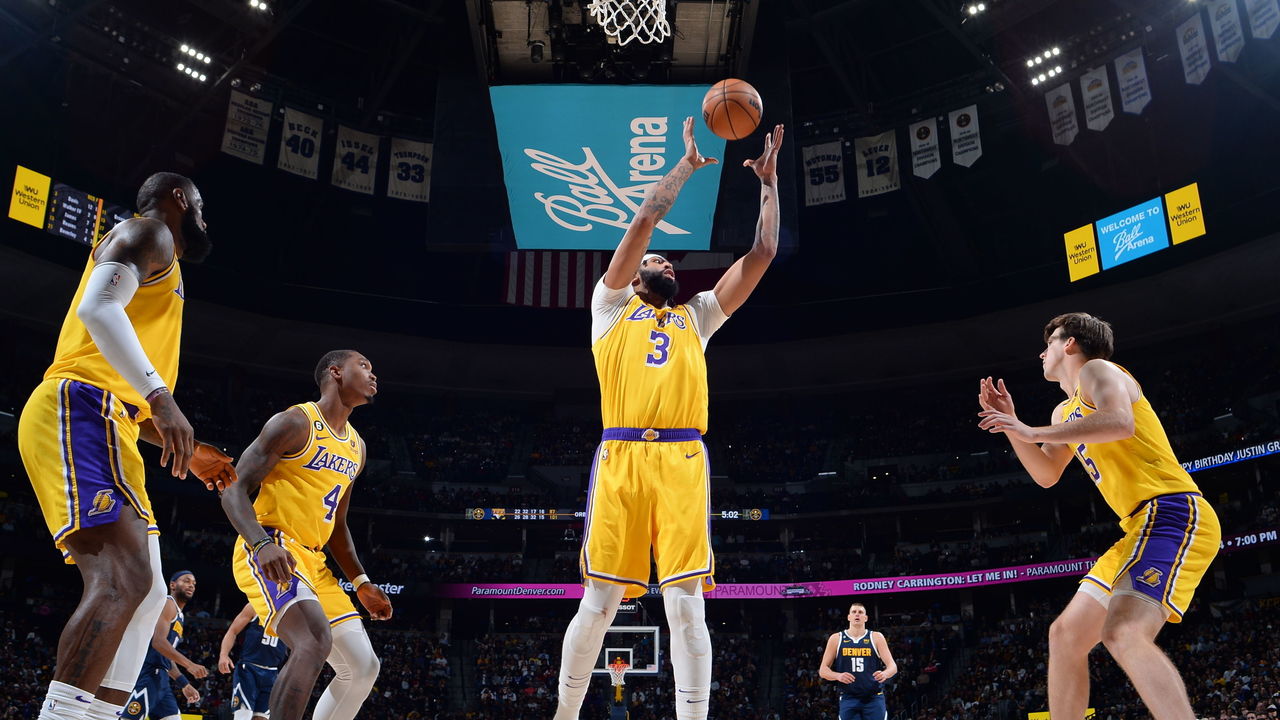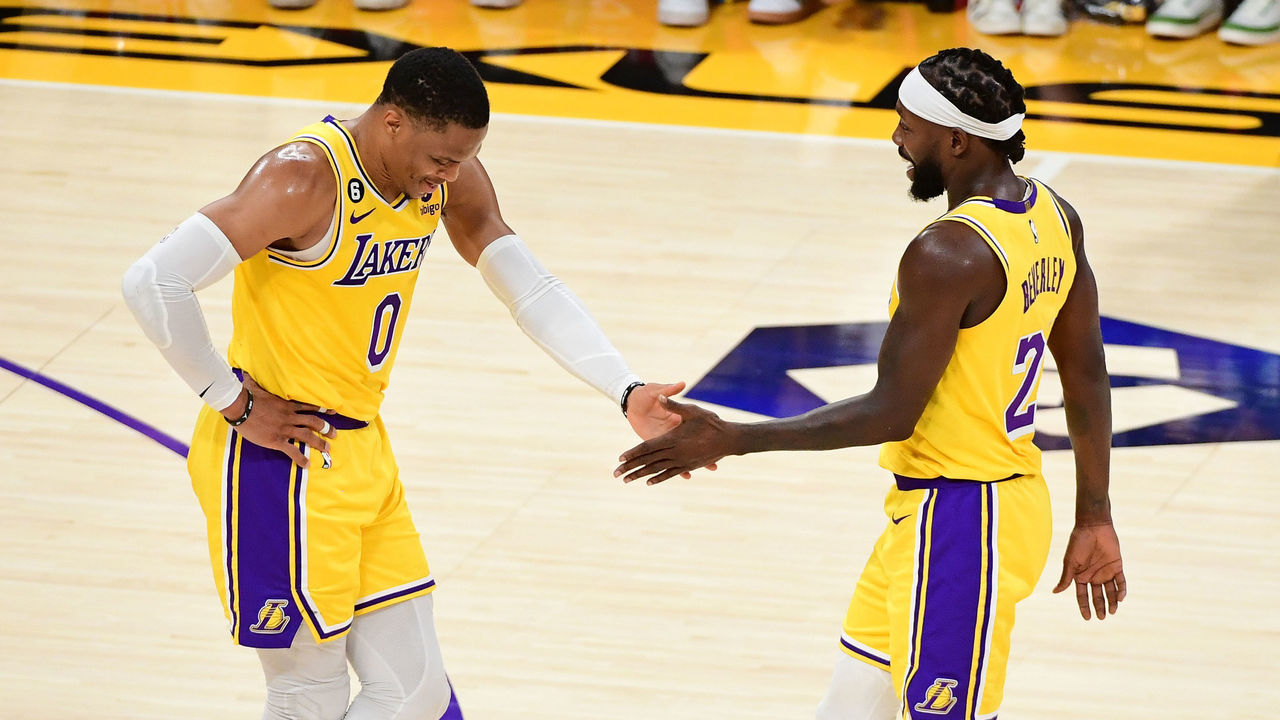How much has the Lakers' recent play changed their trade calculus?
Ever since the Los Angeles Lakers' offseason concluded with Russell Westbrook and both their tradeable first-round draft picks still in tow, the team has been stuck in something of a holding pattern. Structural change felt inevitable once it became clear early last season that the Westbrook acquisition was a flop, but there hasn't been a straightforward blueprint laying out the shape that change should take.
Conventional wisdom holds that when you employ LeBron James and Anthony Davis, you expend every available resource to give yourself the best chance to win in the present. But the calculus was more complicated for these Lakers, coming off a 33-win season, with James in a gentle decline phase entering his age-38 season and Davis struggling to stay on the floor.
Were they good enough to push all their remaining chips in for immediate upgrades? Would it be wiser to take a more patient approach, swallowing some short-term pain while waiting for Westbrook's contract to come off the books and another first-rounder to come into play? Would a more conservative play for marginal improvement bring the best of both worlds, or the worst?
The picture got even murkier when L.A. started the season 2-10, as the whole team clanked through an epic shooting funk and James missed time with an adductor injury. There was even talk (though entirely speculative) of another potential path, wherein the Lakers would go the opposite direction and trade their superstars to restock their long-term assets. But then they pulled themselves together and rattled off eight wins in their next 10 games to re-enter the fringes of Western Conference relevancy. They've since lost two straight, but both came without Davis and one came without James, as well.
The Lakers now sit 10-14, with two games and three teams separating them from a play-in spot. That's far from inspiring, but signs of life abound. They've collectively shaken out of their 3-point shooting coma (it's now more of a light slumber), and their offensive identity has coalesced around pace and relentless rim pressure. When they've been healthy, their defense has been connected and disciplined, forcing a boatload of mid-range shots and sending opponents to the free-throw line at the league's lowest rate.
Westbrook has helped stabilize both the starting lineup and the second unit by finally accepting a move to the bench. Patrick Beverley, despite being a complete disaster on offense so far, has fortified the point-of-attack defense. So has Troy Brown Jr., whose smart cutting has also provided some handy offensive wheel grease. Lonnie Walker has been a whirling dervish in transition and has harnessed his energy in the half court with reliable spot-up shooting, explosive closeout attacks, and acrobatic finishes. Austin Reaves has built on last season's unexpected rookie contributions, blossoming into an invaluable offensive connector and perimeter defender.

Meanwhile, the two superstars at the top of the roster have held up their end of the bargain. James isn't the all-consuming two-way force he once was, but he's still an elite offensive orchestrator capable of erasing space with his defensive help rotations when he decides to empty the tank every third game. After a rough start to the season, he's averaged 27.1 points on 58.9% true shooting since returning from a five-game absence, though that uptick in efficiency has been powered by unsustainably hot 3-point shooting (over 45% on nearly eight threes a game).
The most important development, as it was always going to be, has been the incredible resurgence of a healthy Davis. Of course, the "healthy" piece of that equation is an unstable variable, subject to change at a moment's notice. But while an illness currently has him out, the reigning Western Conference player of the week is otherwise in peak physical form and playing some of the best basketball of his career, dominating at both ends and pumping oxygen into a season that was on life support.
Davis missed half of last season and struggled to find a groove in any capacity - as a play finisher, self-creator, or as the Lakers' last line of defense while transitioning to a more center-oriented role he'd long avoided. This year he's played the five for almost every minute he's been on court, and things have gone much smoother. With better health and a bit more help in front of him, we're seeing All-Defense AD, the version that can put out multiple fires on one possession as a back-line helper, and routinely blow up pick-and-rolls by stunting at the ball-handler before recovering to swallow the roll man at the basket.
At the other end, he's rolling harder, hunting his own offense more assertively, attacking before double-teams can arrive, and shooting better from all three levels. He was a below-average pick-and-roll finisher last season, which owed in part to the Lakers' poor spacing and lack of pull-up threats on the other end of those pick-and-rolls. Those issues still exist, but the Lakers have mitigated them by playing Davis as the lone big man more often and by running snug pick-and-rolls that see him set ball screens below the free-throw line.
He's finishing more possessions per game as a roller than anyone other than Joel Embiid, and averaging an outrageous 1.39 points per possession on those plays. He and James rank third and fourth in the league at per-game scoring inside the restricted area. Since James returned from his injury absence, the Lakers have posted a sizzling 120.4 offensive rating and plus-8.1 net rating in 148 minutes with both of them on the floor.
The Lakers as a team lead the league in at-rim attempt rate, taking more than 40% of their shots within four feet of the basket, per Cleaning the Glass. That partly speaks to their inability to shoot threes (their shots have to come from somewhere), but it also showcases an impressive proclivity for interior scoring, especially given how often their opponents ignore them on the perimeter in order to pack the paint.
This team still obviously has myriad issues. There's an Everest-sized drop-off from Davis and James to the rest of the roster, the guard and wing corps are flimsy as hell, and there still isn't nearly enough shooting. None of the teams currently occupying top-10 spots in the West look like obvious candidates to fall off (depending on which lane the Jazz ultimately pick), and the Lakers have one of the league's toughest remaining schedules. That brings us back to potential trades, how willing the Lakers should be to make one, and who or what they would target.

There's that much-discussed Myles Turner-Buddy Hield framework with Indiana, though given how well Davis has played while handling full-time center duty, acquiring a big man doesn't feel like the best use of resources. Turner could complement Davis on a huge and stifling defensive back line while largely staying out of his way on offense, and Hield's movement shooting would be a huge boon, but off-the-dribble creation feels like a bigger need, doubly so if Westbrook winds up outbound in a deal.
Davis remains a limited playmaker, and James needs more help in that regard. Westbrook, for all his flaws, is still a very good passer and downhill attacker; a huge chunk of Davis' offense has come on the receiving end of his pick-and-roll feeds. Dennis Schroder can't be the team's most reliable secondary ball-handler, which is why the Turner-Hield package doesn't feel especially appealing given what it would cost.
Westbrook's $47-million salary would be needed for matching purposes in a bigger deal like that, on top of 2027 and 2029 first-rounders, likely with light protections. Packaging Beverley and the massively disappointing Kendrick Nunn instead would still allow the team to bring back close to $23 million, and there are plenty of plausible frameworks there that would make the Lakers better without plundering their entire remaining draft-pick stockpile. That said, given that such a move might preclude them from making a bigger splash down the road - which they could conceivably do by dangling multiple first-rounders or opening up near-max cap space next offseason - they'd need to choose extremely carefully.
Would a smaller-scale deal for one of Utah's guards (Mike Conley, Jordan Clarkson, or Collin Sexton) move the needle enough? How about Bojan Bogdanovic and Alec Burks from the Pistons (a package that, crucially, wouldn't impact L.A.'s cap sheet beyond this season)? Charlotte looks primed to tank and ought to be able to offer one or two pieces that pique the Lakers' interest, between Gordon Hayward, Terry Rozier, P.J. Washington, Kelly Oubre, and even Mason Plumlee. (Upgrading Davis' backup is still very much worth doing if it can be done cheaply.)
That all sounds pretty underwhelming, but it's not clear there's a splashier move to be made that would get the Lakers close enough to true contention to justify mortgaging what's left of their future. It might be worth chasing a high-end playmaking wing like DeMar DeRozan, should he become available. It also might make more sense to let Westbrook's contract come off the books and chase a free agent like Kyrie Irving or Draymond Green (or both!) in the summer.
None of these are easy decisions, and the Lakers have to weigh all of them against their belief in LeBron and AD's ability to stay healthy and sustain this level. It's just nice that the team has played well enough to actually put those decisions in play.
There are a handful of very good teams in the West, and the Lakers have a big gap to close if they want to be counted among that group. But there's no runaway favorite, either, and L.A. can still arguably lay claim to the best one-two combo in the conference. It was easy to roll one's eyes when the team's stars lobbied for roster upgrades during their miserable start to the season, but they've since made a compelling case for reinforcements.